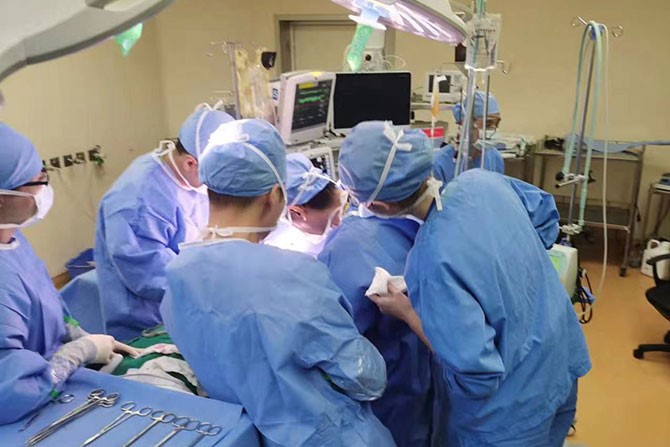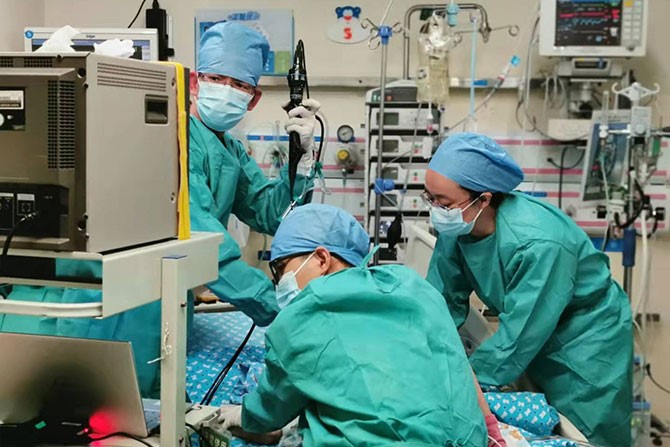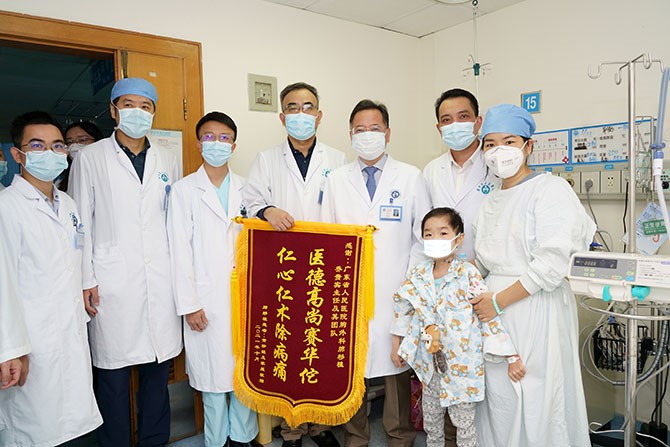

The 8-year-old girl Xiao Linglong (pseudonym) recently has gone through another hurdle.
About half a month ago, the girl, coming to Guangzhou from Hangzhou, Zhejiang province, had a double lung transplantation in Guangdong Provincial People’s Hospital (hereinafter referred to as “the Hospital”). In the ward, recovering gradually, she sang to doctors and nurses and drew a family portrait.
On 1st November, she recovered and was discharged from the Hospital. Hence, the Hospital has set a record of successful lung transplantation for patients at the youngest age in South China.
Two Relapses of Leukemia Endanger the Girl
Xiao Linglong is from Wenzhou, Zhejiang province. Unfortunately, she was diagnosed with acute lymphoblastic leukemia at the age of three. Despite chemotherapy, she suffered leukemia relapses in 2018 and 2019. In the summer of 2019, her father succeeded in transplanting his bone marrow and peripheral blood hematopoietic stem cells into her.
But unexpectedly, less than a year after the operation, she developed graft-versus-host disease of liver, lungs and skin. Although continuous anti-rejection therapy had alleviated the progression of liver and skin lesions, the worsening lung rejection made her increasingly feeble. That meant she had to live by a high flow of oxygen. Under this circumstance, double lung transplantation was her only hope to return to normal life.
Good news came on 16th October, 2021. The Chinese human organ allocation and sharing computer system showed that a pair of donated lungs in Guangzhou matched Xiao Linglong’s. Hearing the good news, she and her mother hurried to take the high-speed train to Guangzhou.
It was the first time for the Hospital to perform such operation on such a young child. For better results, the Hospital urgently gathered experts from various Departments including Thoracic Durgery, Anesthesiology, Cardiopulmonary Bypass, Bediatric Intensive Care Unit (PICU), and Rehabilitation to conduct multidisciplinary consultation in an effort to improve necessary preoperative examination. In particular, two experts, vice president Chen Jingyu from the Second Affiliated Hospital of Zhejiang University Medical College and director Wu Bo from Department of Lung Transplantation of Wuxi People’s Hospital, were invited to engage in the operation and postoperative management.

At 12: 00 on 17th October, the girl was wheeled into the operating room after everything was ready. Shu Haihua, director of the Provincial Department of Anesthesiology, coupled with the team members, made anesthesia assessment and preoperative preparation for her based on the anesthesia management plan drawn up prior to the operation.

At 2:00 p.m., the lung transplant operation got started with the news that the donated lung matched with hers. The anesthesia team accurately controlled one-lung ventilation, stabilized hemodynamics and managed volume with visualization technology and minimally invasive/non-invasive sensing technology to monitor hemodynamics, body temperature, and anesthesia depth during the operation. Qiao Guibing, administrative director of Thoracic Surgery Department of the Hospital, Ben Xiaosong, deputy chief physician, and Chen Jingyu, worked together and successfully completed the operation in 4 hours and 15 minutes, with only 50 ml of bleeding during the operation.
The Girl Reborn with Intensive Postoperative Care
On 26th October, Xiao Linglong got out of the bed without wearing an oxygen mask for the first time after the transplantation. She supported the bed bar, singing her most favorite and familiar song—Healing Love and dancing.
Moved out from the operating room, she was immediately transferred to the children’s ICU for follow-up treatment and monitoring. Guo yuxiong, administrative director of PICU in the Hospital, is fairly pleased seeing that the girl is recovering. He says,“In addition to the difficult technical operation during the transplantation, monitoring and treatment in post-operation are also tricky. Thus, a standard follow-up after discharge is significant.”
Qiao Guibing points out the key point: “Rejection and infection are an important contradiction in lung transplantation, and also the most difficult part.” He explains that anti-rejection drugs must be used after the transplantation in a bid to reduce children’s immune response. However, the lungs exchange air every day so they are easily infected by bacteria in the air after worsening immunity. The infection would produce unimaginable consequences. Therefore, the key point of postoperative management lies in how to strike a balance between rejection and infection.

Thanks to the meticulous care of Guo Yuxiong’s team and specialist nurses such as Wu Yinghong, head nurse of Thoracic Surgery Department, the girl was able to get rid of tracheal intubation on the first day after the operation. On the eighth day, she was transferred back to the transplant ward of the Thoracic Surgery Department for continuous postoperative rehabilitation. It was the early offline and sequential non-invasive support, strict liquid management, hemodynamic monitoring, immunosuppressive therapy and monitoring, early control of acute rejection, multiple prevention and control on infection, and early lung rehabilitation training that contributed to her sound recovery.
On the tenth day, she was already able to deoxygenate for more than 6 hours without any discomfort. On 1st November, she recovered and was discharged from the Hospital.

Qiao Guibing adds that although the cases of lung transplant in China have increased significantly, such cases related to children are few. It is not until October, 2019 that there are successful lung transplant cases of children under ten years old in China. The main reasons restricting the operation are the lack of children’s lung donation and the difficulty in matching, together with their small physique and their poor cooperation, making children’s lung transplant operation and postoperative management more tricky and complicated than adults’. All in all, the girl’s successful operation will serve as a piece of valuable experience for the Hospital to perform similar operation.
By the end of 2019, the Hospital had acquired four organ transplant qualifications of heart, lung, liver and kidney, being one of the three hospitals in Guangdong province that obtained the above qualifications. Yu Xueqing, president of the Hospital, says that organ transplantation is an effective treatment as it can help patients with end-stage organ failure to return to normal life.
He adds that the Hospital is striving to set up a transplant department and open new wards. To give full play to discipline and team strengths in heart, lung, liver and kidney transplant, surgeons specialize in enhancing surgery, and physicians in postoperative monitoring, nursing and follow-up in an attempt to improve the Hospital’s organ transplant services.
Source: Nanfang Daily, Nanfang+